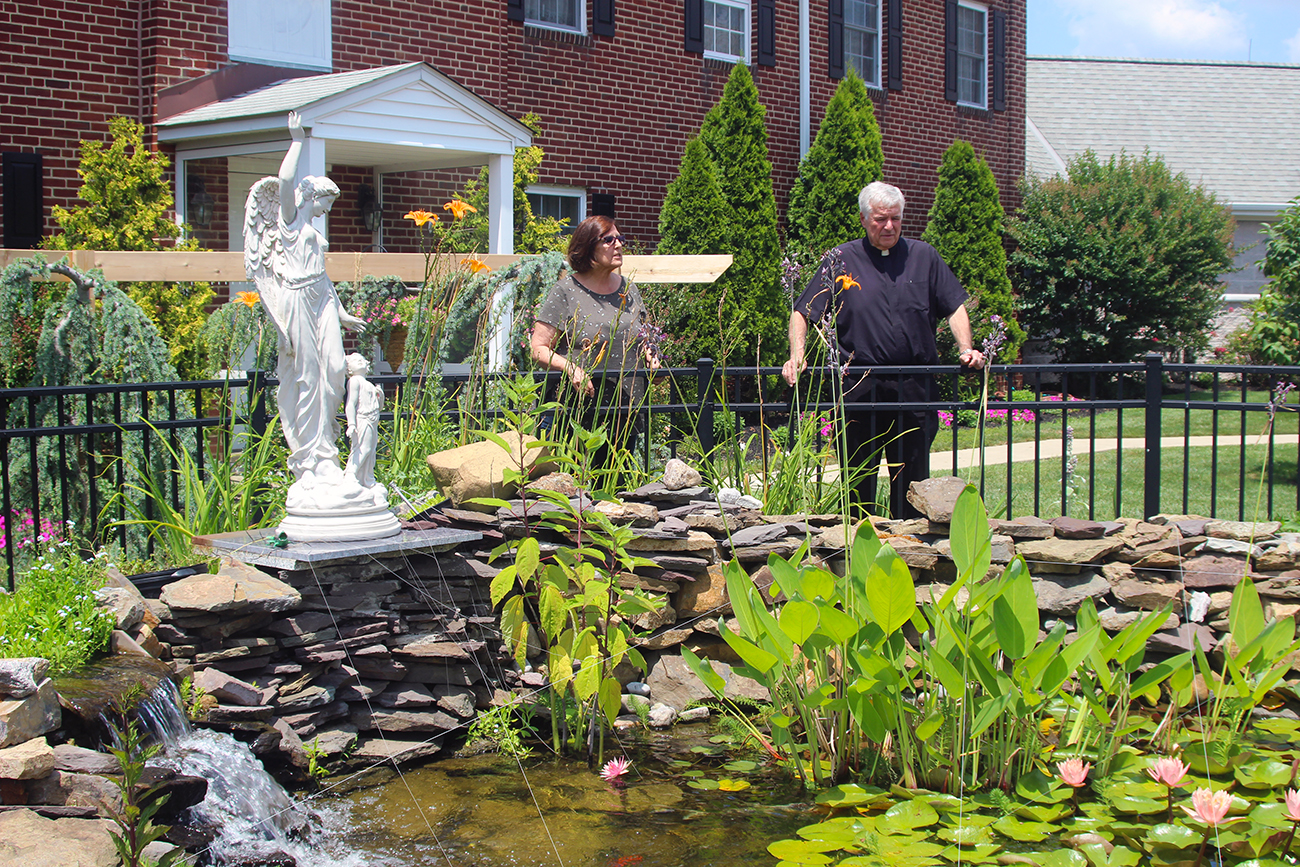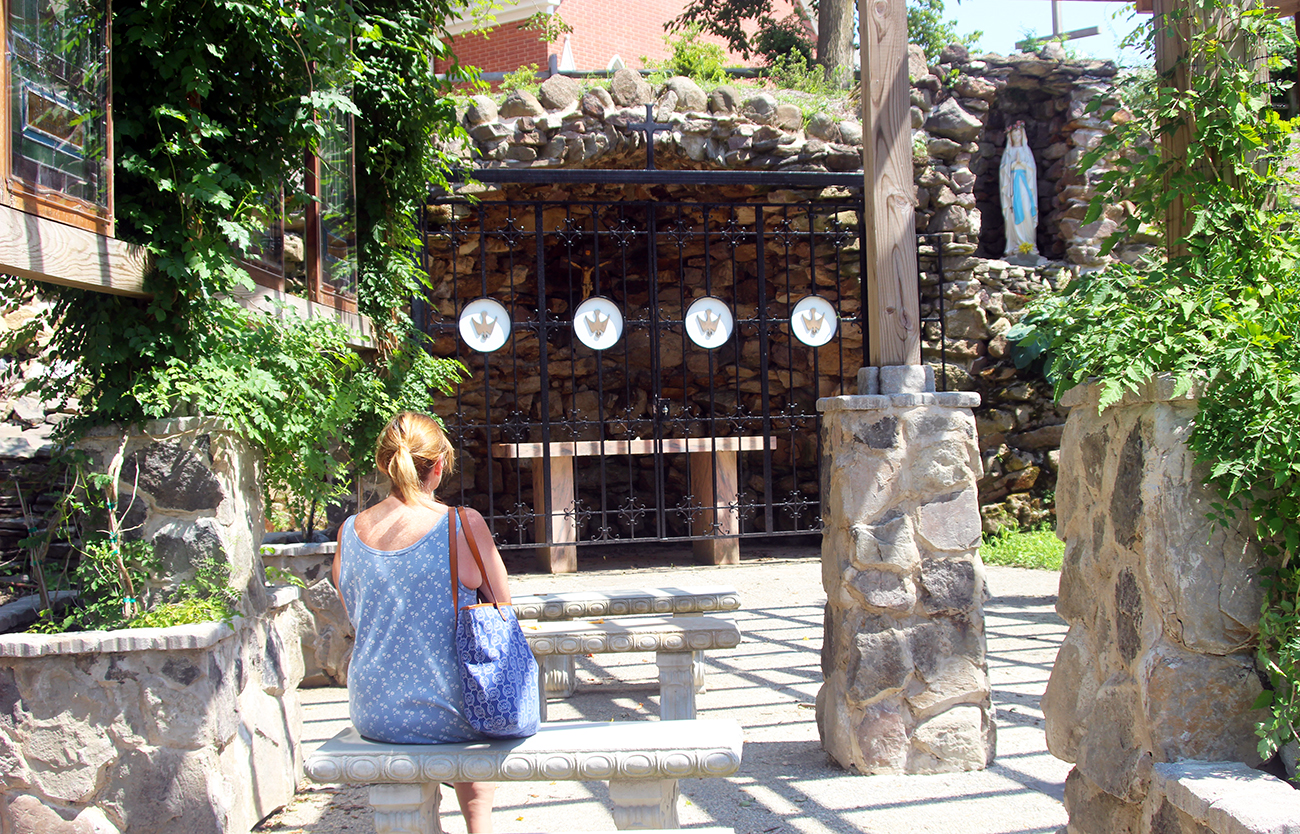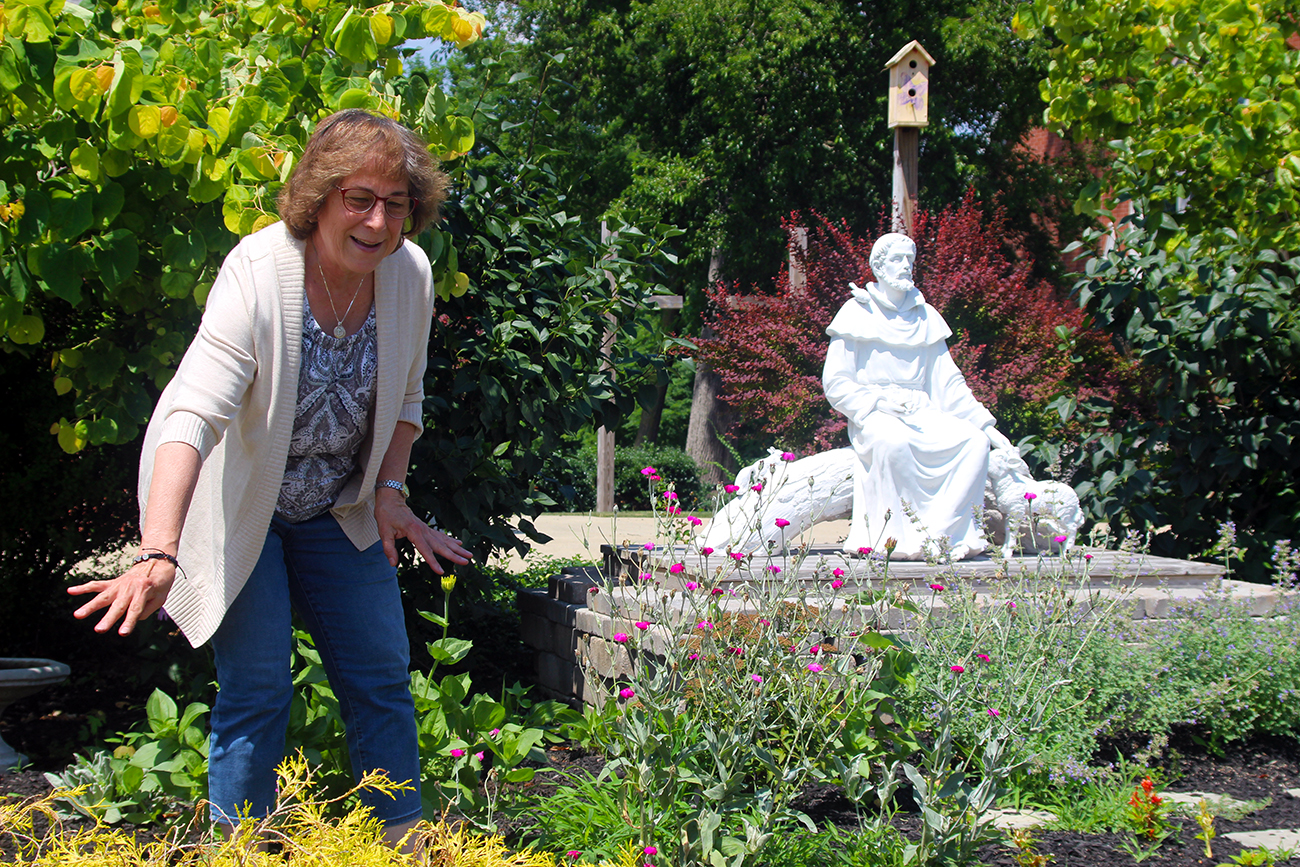
Msgr. Joseph Nicolo, pastor of St. Helena Parish in Blue Bell, examines a garden pond in front of the rectory with parishioner and garden club coordinator Theresa Smith, July 9. The pond, designed by former parochial vicar Father Tadeusz Gorka, is a memorial to three parish children who died of cancer, and forms part of the parish’s extensive network of garden shrines. (Photo by Gina Christian)
Msgr. Joseph Nicolo wants you to know that you’re on sacred ground the moment you arrive at St. Helena Parish in Blue Bell, where he serves as pastor.
Angel statues stand guard at the six entrances to the parish campus, which features more than a dozen gardens, an outdoor chapel area, roadside Stations of the Cross and a memorial pond.
(View a photo gallery of St. Helena Parish’s prayer gardens.)
“You’re coming to a place of prayer,” said Msgr. Nicolo. “Mass is the most important act of worship, and you’re being reminded of that as you drive by these grottos and shrines.”
[hotblock]
The lush gardens, diligently tended by various parishioners, all started with some discount mums Msgr. Nicolo purchased at Walmart about 20 years ago.
He was inspired by a neighbor across the street, an enthusiastic gardener whose son happened to be Father James Catagnus, the recently retired pastor of St. Ambrose Parish in Philadelphia.
Seeing the Catagnus family’s “magnificent flowers,” Msgr. Nicolo began planting, “and from there it just grew,” he said.
The parish grounds, which now span 37 acres, have had several shrines over the last hundred years, said Msgr. Nicolo, although the gardening initiative gained real momentum in the last two decades.

A parishioner prays at an outdoor grotto chapel located behind the sanctuary of St. Helena Parish in Blue Bell, July 9. Built by parishioners, the chapel has become a popular site for reflection and rosary recitations.
Established in 1919, St. Helena’s has always been close to the land. The parish began in two area farmhouses, one of which had lodged George Washington’s Continental forces during the American Revolution. The second location, owned by parishioner Ellen Duddy, was bequeathed (along with her livestock) in 1922 to founding pastor Father Francis Higgins, who is buried across from the current rectory.
Past and present are woven throughout the gardens, creating a sense of the eternal that offers comfort amid loss and hardship. A memorial pond in front of the rectory honors three parish children – Erin Moore, John Shapiro and Landon Vargas – who died of cancer within the past 15 years.
In 2016, then-parochial vicar Father Tadeusz Gorka (now at Sacred Heart Parish in Royersford) designed the richly symbolic pond, the focal point of which is a guardian angel statue protecting a young boy. The pond’s waterfall represents God’s grace; the short distance of the cascade reminds viewers of the brief lifespan of the deceased children. Fish, snails, frogs, water lilies, hibiscus and surrounding evergreens attest to the gift of everlasting life.
Behind the church, a replica of the Lourdes grotto has been expanded to form an outdoor chapel, with a stone floor and a vine-covered pergola. Stained glass windows from the parish’s second church (which was succeeded by a new one in 2004) have been sealed with protective plexiglass and hung from the pergola’s rafters, along with Stations of the Cross plaques from the former convent. The altar from the previous church stands securely in the grotto behind an iron grille.
At present, Masses are not celebrated in the outdoor chapel, but a rosary prayer group – which used to meet indoors — now gathers there on Wednesday mornings, said garden club coordinator Theresa Smith.
Although the move was prompted by social distancing requirements from the pandemic, Smith said that “when you sit there, you feel the peace.”
[hotblock2]
Under COVID-19 restrictions, parishioners were drawn more than ever to the outdoor shrines, said Msgr. Nicolo.
“When people weren’t able to go to church, you would see them driving up, stopping in front of St. Francis of Assisi or St. Joseph, or they’d drive along the Stations of the Cross and pray them from their cars,” he said. “Other people would go to the grotto and say their prayers and meditate.”
Smith noted that the maintaining the gardens is the work of many hands. Parishioners donate labor, time and materials to each of the shrines, and even constructed the outdoor chapel’s pergola themselves. Several of the sites were built as Eagle Scout projects, and students from area schools have tended the grounds as part of their community service.
The most pressing task, by all accounts, is weeding.
“I can’t walk by and leave the weeds there,” said parishioner Mary Jane Mrazik. “They have to come out.”
Mercedarian Brother Matthew Levis, the parish sacristan, agreed.
“It’s all about the weeds,” he joked. “The most rewarding part is when they don’t grow back.”
The vigilance is well worth it, he added, noting that the grounds foster an atmosphere of “serenity and new life.”
Parishioners such as David Ebbott often stroll through the gardens on a daily basis.
“My wife and I love the fact that we can come here to pray, since we’re outdoor people,” he said. “It’s a sanctuary, and we love that our dog can come with us.”
Such visits may soon include a chance to harvest some fresh produce, as plans for a parish vegetable garden are under discussion, said Smith.
The steady spread of beauty across the parish campus continues to reflect “where heaven and earth touch” in the Mass, said Msgr. Nicolo.
“That’s where the mysteries of the faith are broken open,” he said. “And these shrines and gardens are just other opportunities to experience that.”

Mary Jane Mrazik, a member of St. Helena in Blue Bell, tends the parish’s St. Francis of Assisi garden, July 9. Dozens of parishioners maintain the numerous shrines and gardens on the parish’s 37-acre campus. (Gina Christian)
PREVIOUS: Priest’s calls makes difference for St. Laurence parishioners
NEXT: Archbishop learns what’s on minds of Chester County young adults



Share this story